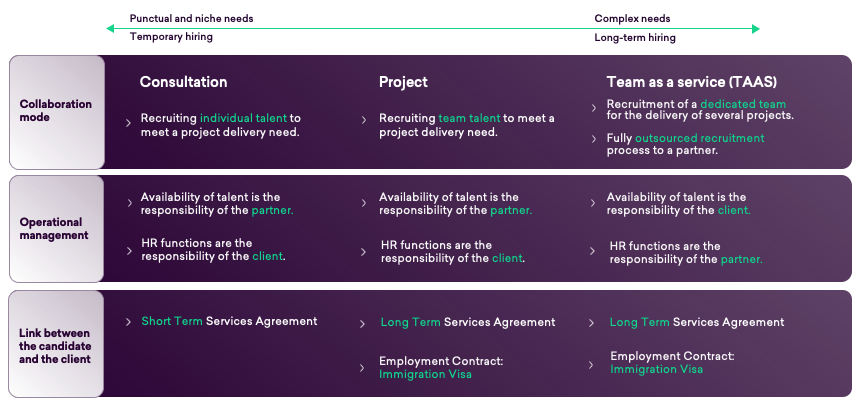
Delivering IT projects
across borders:
an indispensable strategy
With the shortage of qualified workers, it has become crucial for companies striving to grow to adopt a recruitment strategy that helps them to succeed. However, let’s face it: the context is not the easiest right now. Why has it become so difficult to hire qualified IT talent? There are many reasons. First of all, let’s remember that we are in a market where demand is high (and it’s not going to stop anytime soon). In addition, the local market is a physically limited pool. Currently, supply is only slightly higher than demand.
What can you do if you want to hire skilled labor? Break down borders and start recruiting internationally.
International recruitment: what are the barriers?
Although it is a time-tested recruitment process, many companies are still reluctant to hire international talent. There are still many unanswered questions that prevent many managers from taking the plunge.
Here are some examples:
- How do I manage different time zones?
- How do I develop multicultural team spirit?
- How do I recruit talent with the same level of expertise as our local teams?
- How do I manage our HR strategy and logistics effectively?
- How do I build trust with talent based worldwide?
- How to manage international pay equity?
Without a proven recruitment process and well-honed tools, it is truly difficult to successfully attract and hire talent. With a well-aligned recruitment strategy and specific measures, it is entirely possible to generate very interesting results.
You just need to rethink the way you approach the talent marketplace… and be prepared to rethink some of the ways you work.
Succeeding at international recruitment takes an effective strategy
First of all, let’s remember that it’s possible to meet the needs of clients through different types of hiring. In today’s local market, the name of the game is “flexibility.” This is the perfect time to be creative and propose multiple solutions to multiple problems.
Here are a few examples of possible hires:
- Internal hires
- Staffing
- Outsourcing
- Hybrid method ( a combination of several methods)
It is therefore possible to use these same types of hires for an international candidate market. In a second instance, it is critical to clearly map out your needs. Here’s an example of what we do at Logient:
- Consulting: To meet this client’s needs, talent needs to be recruited on a piecemeal basis.
- Project: To fulfill this need, it is necessary to recruit a team. This team will be responsible for delivering a project.
- Team as a Service (TaaS): To deliver this project, you need to recruit a dedicated team. It will be responsible for delivering many projects.

It’s very important, before embarking on any international hiring program, to clearly identify your needs. These needs will have a significant impact on the direction of your recruitment strategy. If, for example, you have specific and niche needs, your recruitment plan will definitely lead you to a temporary hire. If your needs are complex, you will turn to long-term hiring.
Tailoring your tactics and tools
Embarking on an international talent acquisition journey does not come without some preparation. Your approach will change if, for instance, you want to recruit talent in Tunisia, New Zealand or Mexico. Of course, you have to think about not only the language there but also the tools you will need to use. It’s not a matter of scrapping what you have, but rather expanding your HR arsenal.
Here are some tactics and tools to consider if you opt for international recruiting:
- LinkedIn Recruiter (rather than LinkedIn Premium)
- A network of international recruiters
- Recruiting partners (international recruitment firms or overseas business partners)
- Posting on international job boards
- Participating in international recruitment events
- Candidate-employer matchmaking platforms:
- UpWork
- TopCal
- Klicklox
- Talent Montréal
The important thing here is to be visible to the talent pool you require — and do it the right way. Remember that international recruitment is a world of its own. If you rely on partners who already know the countries you want to penetrate, you will be noticed much more quickly. You will be able to adapt not only your approach but also your pitch, leading to a much more favourable response.
In Logient’s case, we rely on recruiters located internationally to help us approach the candidates we want. Of course, your budget will be different if you, for example, choose to use recruiters on-site. But the results are often better.
Promote the position differently
Once you want to offer candidates from abroad one or more positions, you cannot offer them a job in the traditional way. Of course, you and the candidate must discuss the compensation package and the duties of the job. But what you really need to do more than anything else is sell the work environment — the most important part of your pitch to the candidate.
- Flexibility: it is critical for candidates to understand that the employers are willing to use distance to their advantage and offer a package “tailored” to their needs. The manager has an important role to play in reassuring and supporting the feasibility of quality work for the candidate and his/her future team. Do not hesitate to put your candidates in contact with your international employees.
- Mobility: Candidates must feel that they can work remotely and relocate locally (or vice versa). The prospect of travel is interesting for many candidates. You must sell the possibility of working not only on different projects, but also in a work environment that can change.
- Integrity: Candidates must feel that, despite cultural and lifestyle differences, integrity is a constant every step of the way.
With an international talent acquisition strategy, it’s important to understand that you do not pitch to a candidate in the “traditional” way. In addition to selling the position, you also need to sell the prospect of an adventure and the work environment itself.
Questions that concern us
Recruiting internationally raises many questions. It’s normal to ask yourself certain questions that would not come up during a “standard” process. Not all companies are as comfortable with this approach.
Here are some examples of questions to consider:
- Qualifications: How do you assess the skills of any candidate? Can candidates who have a strong command of the necessary technology in their country of origin apply their technical knowledge here? Can you properly assess their knowledge and differences? Can you see the nuances?
- Answer: You should ask the candidates to take technical tests. This way, you can be sure that they have the necessary level of knowledge and know-how.
- Interpersonal skills: how do you validate interpersonal skills? If you need to meet candidates from many different cultures, how can you ensure that they can adapt to our corporate culture and our culture at large? How can you be sure that they will understand the vision and mission of the company?
- Answer: To successfully integrate candidates, you should always conduct coaching sessions and role-playing exercises with them.
Let’s not forget that, despite the fact that technology is a universal language, projects are not always delivered the same way in every country. Talent can therefore possess solid technical expertise that is not picked up during a job interview or, subsequently, during the delivery of a project. For this reason, it’s crucial to keep in touch with your resources.
Going beyond the traditional hiring process
You also should not overlook the whole aspect of somebody’s personal life. When workers choose to immigrate, it’s important to remember that they are leaving not only their own country, but everything around them, including their family, friends and customs. You must do your best to make them feel as comfortable as possible, once they arrive.
Here are some tips:
- Develop a mentoring program: You can assign mentor to individuals, who can act as guides for these new employees, making their integration smoother. This is a “coach” that can help any employee feel much less alone and make a big difference.
- Create a newcomer’s guide: This is a guide that can provide new employees (and their families) with resources to better integrate into the company. For example, it could include, for example, information on how to find housing the simple way or how our health care, banking and insurance systems work. This is a valuable tool for international candidates that can only help them adapt to their new life and job more easily.
- Make short videos in both languages: It is always wise to make short videos that help new employees find the information they need to learn more easily and quickly. Even if it involves some work, consider producing these videos in both languages. This can help these employees to better find their way when they arrive.
Naturally, this requires a considerable amount of work beforehand. But it’s well worth the investment, if you think about the well-being it can bring employees from abroad. For them, the environment for them is different, so it’s crucial to be more involved with them than you would be with employees who are already here.

A return to the essential
Although attracting and hiring talent from abroad requires strategy and deployment on a larger scale, it’s well worth the effort.
Of course, creating the documentation and procedures for this strategy takes some work. However, once everything is in place, it’s only a matter of updating it all.
If you look at the big picture, it’s just a matter of bringing back the best HR practices to the forefront. You are not reinventing the wheel here. You are simply embarking on a journey that requires you to pay much more attention every step of the way.
- Implement performance measures
- Set clear expectations and follow up on a continuous basis
- Be willing to collaborate and be open to change
- Document and share internal procedures
- Build a relationship of trust
- Focus on the essentials
Basically, it’s a matter of applying what you do with your local talent….with international candidates. The pool is just much larger. And by doing it right, it’s a win-win-win for everyone — the client, the candidate and, of course, the employer.
And, what if everything you put in place could also allow your local employees to work from abroad?




















